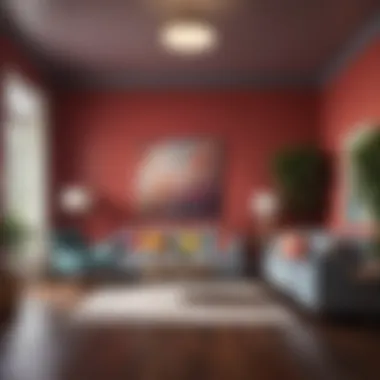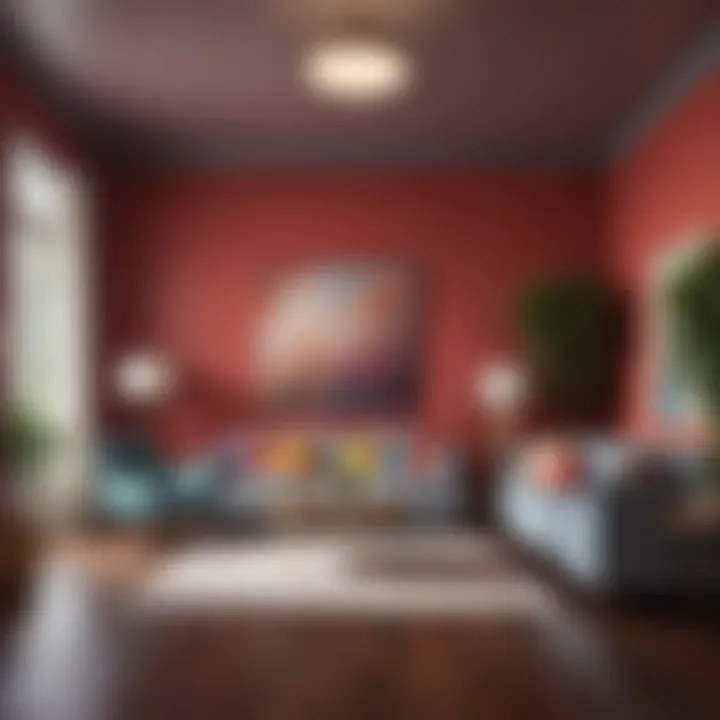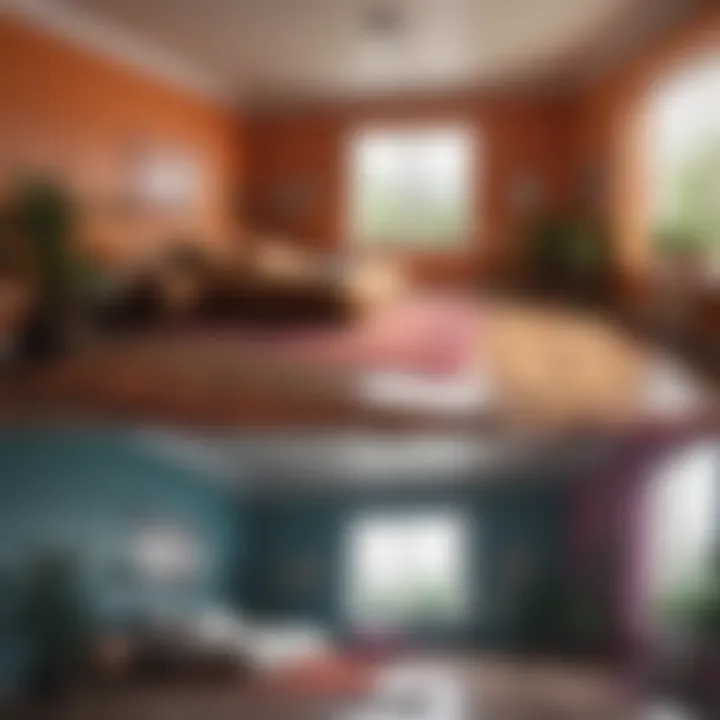Mastering Room Color Selection for a Harmonious Space


Intro
Choosing a color for a room is not just an aesthetic choice; it's a decision that can significantly affect mood, perception of space, and overall comfort. Colors can evoke emotions, create illusions of larger or smaller spaces, and even influence our daily routines. Understanding how to determine the ideal color for your room requires a comprehensive approach, taking into account personal preference, psychological impacts, and spatial dynamics.
This guide will explore various aspects of color selection, from the latest design trends to practical strategies for visualizing outcomes. It aims to help you navigate the often complex process of color selection with informed strategies that will lead to a harmonious living environment.
Design Inspiration
Creating the ideal ambiance for your space starts with inspiration. Analyzing current design trends and popular color schemes can spark creativity and lead to more personalized choices.
Current Trends in Interior Design
In recent years, the world of interior design has shifted towards embracing bold colors and sustainable choices. Earthy tones such as terracotta, olive green, and muted blues are trending. These colors often create a serene atmosphere, fostering relaxation and well-being. Furthermore, the emphasis on biophilic design has popularized greens, with various shades mimicking the natural foliage of indoor plants.
While neutral shades remain classic, designers now recommend incorporating vibrant accents through accessories, artwork, or statement walls. This approach allows homeowners to express individuality without overwhelming their spaces.
Color Schemes and Palette Ideas
When building a palette, it’s essential to consider harmony and balance. Here are some effective color schemes:
- Monochromatic: Utilizing different shades of a single color creates a unified and sophisticated look. For instance, a spectrum of blues can provide depth and texture.
- Analogous: Selecting colors next to each other on the color wheel fosters harmony. Greens paired with yellows and blues evoke freshness and vitality.
- Complementary: This approach means using colors from opposing sides of the color wheel. For example, pairing orange with blue can create a lively contrast, ideal for areas meant to stimulate creativity.
"The right color palette is not only visually appealing; it can also enhance the functionality of a space by guiding energy flow."
Remember to account for lighting, as it significantly impacts how colors appear at different times of the day. Natural light may soften colors, while artificial light can alter their appearance entirely.
Practical Strategies to Visualize Outcomes
Visualizing how a potential color will look within your space is crucial before making a final decision. Here are some suggestions:
- Sample Paints: Always test paint samples in your space to see how they interact with lighting and furniture. Paint swatches on walls can help gauge the overall effect.
- Digital Tools: Use online color visualizers that allow you to see how different colors work in a digital version of your room. Many paint brands offer apps or websites for this purpose.
- Mood Boards: Create a physical or digital mood board compiling various hues, materials, and inspirations to determine which colors resonate most.
By weaving these elements together, you can cultivate a thoughtfully designed space where every color choice contributes to the ambiance and functionality.
Understanding Color Psychology
Color psychology plays a crucial role in interior design and can significantly affect our emotions and perceptions. Understanding color psychology is not just about aesthetics but also about the psychological and emotional impacts colors can have on individuals within a space. Each color evokes distinct feelings and thoughts, influencing not just mood, but also behavior and even productivity.
Awareness of how colors can affect human emotions is essential in making informed choices about room colors. For instance, warm colors such as red and orange might create a sense of warmth and excitement. In contrast, cool colors like blue and green often induce calmness and tranquility. By paying attention to these elements, one can tailor spaces that align with their intended use, boosting functionality and comfort.
Additionally, different colors can enhance various moods. Warm hues are sometimes perfect for social gatherings, while cooler shades might suit personal retreats.
The Emotional Impact of Colors
Colors resonate on an emotional level. Each hue carries a psychological weight that should not be overlooked. For example, blue is often associated with trust and responsibility, which makes it a common choice for offices or study areas. On the other hand, yellow can energize a room and provoke a sense of cheer. Making decisions based on these emotional associations helps create an environment that reflects desired feelings.
It is important to consider the context. A shade of green may feel fresh and revitalizing in a kitchen, while the same tone might appear dull in a different environment. Therefore, understanding the emotional impact of colors assists in enhancing the character of a space.
Colors and Mood Enhancement
Mood enhancement through color selection can elevate the way individuals perceive their surroundings. For example, utilizing colors associated with relaxation, like soft blues and greens, can transform a bedroom into a serene sanctuary. Conversely, brighter tones can invigorate living areas, encouraging social interaction.
The key lies in matching colors with the intended psychological effect one wants to achieve in a room. Factors such as the time of day, amount of natural light, and personal preferences play a role in these decisions. Therefore, assessing how colors interact with mood can lead to an improved living experience.
Cultural Significance of Colors
Colors also possess cultural meanings that can vary significantly across different societies. Understanding these nuances is crucial for creating harmonious environments. For instance, white is often viewed as a symbol of purity in Western cultures, whereas in certain Eastern contexts, it can signify mourning.
Such knowledge not only enriches the design process but also allows for the incorporation of thoughtful choices that resonate on a deeper level with inhabitants and visitors alike. Exploring these cultural significances offers a broader perspective and adds layers of meaning to color selection.


"Choosing the right color is not just about preference; it can also influence emotional states and cultural perceptions."
In summary, understanding color psychology is fundamental for making impactful color choices in room design. By considering the emotional impact of colors, mood enhancement through color selection, and cultural significance, one can create spaces that are not only visually pleasing but also emotionally harmonious.
Analyzing Room Usage
Analyzing the usage of a room is a critical step in selecting the right color for that space. Understanding how the space is used can directly influence the color choices that are optimal for the environment and its inhabitants. When considering color, it’s essential to think about functionality, the audience that will interact with the space, and the different lighting conditions throughout the day. These factors work in tandem to create a cohesive and harmonious atmosphere in the room.
Functionality of the Space
The primary function of a room dictates its color scheme. For example, a kitchen, often a hub of activity, may benefit more from vibrant and warm colors that stimulate energy and engagement. Blue, on the other hand, might be less desirable due to its calming properties, which are better suited for bedrooms or study areas.
In contrast, a home office should foster focus and productivity. Thus, colors like soft greens or neutral tones can enhance concentration without being distracting. When choosing a color, consider the purpose behind that room.
Audience and Interaction
The audience that will frequently use the room is another vital aspect. A space designed for entertaining guests may call for engaging colors that elicit conversation and connection, such as earthy tones or warm colors like coral. On the other hand, if the space is intended for quiet contemplation, cooler tones may provide the needed tranquility.
Keep in mind the psychology of color concerning the specific demographic. Children might prefer brighter, more playful colors, while adults often lean towards more muted palettes. Understanding who will use the room allows for better alignment between color choice and user experience.
Daytime versus Nighttime Use
Light conditions throughout the day can drastically affect how colors are perceived in a room. Natural light can enhance colors during the day, making them appear more vibrant and lively. Conversely, at night, the artificial lights might alter the way shades are viewed. For instance, a room painted in a bright yellow may feel cheerful during the day but overpowering under artificial light. It’s beneficial to test color samples at different times of the day.
Evaluating Natural and Artificial Light
Evaluating natural and artificial light is critical in the color selection process for a room. Light fundamentally influences the perception of color. For instance, what seems vibrant in daylight may appear dull under incandescent bulbs. Homeowners must consider various factors to ensure that the chosen colors enhance the aesthetic appeal of the space.
Types of Natural Light
Natural light varies based on time of day and weather conditions. Morning light can have warm tones, while midday sunlight appears more neutral. In contrast, the late afternoon sun casts deep yellow hues. This variability impacts how colors reflect within a room.
- Direction of Light: North-facing windows provide cool, even light, while south-facing windows allow more warm light. Understanding this helps in selecting colors that harmonize with the natural light.
- Seasonal Changes: During winter, sunlight is usually softer compared to the harsh bright light of summer. This change can affect color intensity in a room.
- Window Size and Placement: Larger windows will bring in more light, potentially altering the appearance of the colors used within the space.
Artificial Light Sources
Artificial lights encompass a variety of options. Each source has distinct characteristics that can influence color perception differently.
- Incandescent Bulbs: Offer warm, yellow light, which enriches warmer colors like reds and yellows. However, colors can appear less vibrant under these lights.
- Fluorescent Lights: Give off bright white or blue light. These lights can sometimes distort colors, making them appear sharper but less true to their actual hue.
- LED Bulbs: Available in various tones, LEDs offer flexibility. They can replicate natural light quality or emphasize specific colors depending on temperature settings.
Understanding these different sources aids in tailoring lighting solutions to enhance the chosen color scheme.
Impact of Light on Color Perception
The interplay between light and the colors in a room is complex. Each type of light can either enhance or dampen the visual appearance of a color.
"Color perception is never constant; it shifts based on light conditions and surrounding elements."
- Brightness: Colors appear more vibrant in well-lit conditions. Dim lighting can mute tones, leading to disappointment in color choices.
- Reflection: Surfaces in the room will reflect light differently based on their finish. Matte surfaces absorb light, while glossy finishes can amplify it.
- Time of Day: As the day progresses, the quality of light changes. This necessitates testing colors at different times to see how they react over hours.
By evaluating both natural and artificial light, individuals can make more informed decisions regarding color choices in their rooms. Understanding light characteristics and their impact on colors can help create a balanced and aesthetically pleasing environment.
Assessing Room Size and Layout
Assessing room size and layout plays a critical role in color selection. Understanding the spatial dynamics allows for better application of color principles that can transform a room's function and feel. Room dimensions interact intimately with color hues, influencing not just aesthetic appeal but also psychological comfort.
Influence of Room Dimensions
The size of a room significantly determines the color palette that can be effectively utilized. In smaller spaces, lighter colors often create a sense of openness. Pale shades like soft whites or light pastels can make tight quarters feel larger. Conversely, larger rooms may accommodate deeper, richer colors without overwhelming the space. Darker colors can provide coziness and intimacy, which is beneficial in expansive areas that may feel cold or uninviting.
When choosing colors, consider that natural light's intensity can also affect perception of color. For instance, a small room with abundant sunlight could benefit from bold shades to add character, while a dimly lit room might require softer tones to enhance brightness. Thus, the balance between color choice and room dimension is essential.
Understanding Layout and Flow
The layout of a room dictates not just the furniture arrangement, but also the visual flow of color across spaces. A well-thought-out spatial design will ensure that colors complement and enhance movement throughout the area. Open-concept layouts can integrate colors across rooms, allowing for transitional color schemes that span from one space to another, creating a cohesive environment.


In contrast, closed spaces may require distinct colors for each room, helping to define areas while still maintaining a sense of harmony. The key is to choose colors that flow naturally, ensuring that each area feels distinctly engaging without feeling disconnected from adjoining spaces. Thinking about how one will navigate through the space can guide effective color selection.
Creating Illusions of Space
Color can also be utilized to manipulate spatial perception. To create a sense of depth, colors such as cool blues or greens can be applied on walls, making them seem more distant. This technique can help elongate narrow rooms or narrow hallways. For broader areas, warm colors can visually pull walls closer, creating a more intimate atmosphere.
Adding horizontal stripes on walls can also enhance a sense of space. Using light colors for the upper portion of a wall and a darker shade on the bottom can create visual interest while making ceilings appear higher. Moreover, strategically placing mirrors can reflect colors and light, further enhancing the room's perceived size.
In summary, assessing room size and layout is crucial in determining the ideal color scheme that aligns with both functionality and aesthetics. Proper consideration can lead to visually appealing and psychologically pleasant spaces.
Exploring Color Schemes
Understanding color schemes is essential in the context of choosing the ideal color for your room. Color schemes provide a structured way to think about color combinations and their visual outcomes. They can enhance mood, create harmony, and dictate the overall aesthetic appeal of a space. Choosing an appropriate scheme helps ensure that the colors in the room work together rather than clash or overwhelm.
Monochromatic Schemes
Monochromatic schemes involve using variations of a single color. This approach can create a soothing and cohesive look. Different shades, tints, and tones of the same color can add depth while maintaining unity. For example, a living room painted in various shades of blue can evoke calmness and serenity. Using monochromatic schemes can simplify decision-making, as the focus is on one color family. It allows for easy mixing of patterns and textures, making the space more visually interesting without introducing too many competing colors.
Complementary Colors
Complementary colors are located opposite each other on the color wheel. This means they create a stark contrast when paired, leading to vibrant and dynamic spaces. For instance, combining a deep red with a soft green creates a lively and energetic atmosphere. When using complementary colors, it is important to balance the two to avoid overwhelming the viewer. One color can dominate the room while the other serves as an accent. This allows the colors to enhance each other, providing visual appeal without conflict.
Analogous Color Combinations
Analogous color combinations consist of colors that sit next to each other on the color wheel. These colors share similar hues and often blend harmoniously. For example, pairing blue, blue-green, and green can create a tranquil, nature-inspired environment. This color scheme can be particularly effective for spaces intended for relaxation, such as bedrooms or home offices. When using analogous colors, there is a natural flow that ties the colors together. It can evoke a sense of stability and comfort, making the viewer feel at ease.
Utilizing color schemes thoughtfully can transform a room into a meaningful and harmonious space.
Utilizing Color Samples and Visualizations
Selecting the ideal color for a room is a vital aspect of interior design. One of the most effective methods for ensuring that chosen colors will work harmoniously in your space is through utilizing color samples and visualizations. This approach allows homeowners, designers, and enthusiasts to test colors in their environment before committing to a final decision. Understanding this topic enhances the overall design process, providing confidence in color selection.
"Color is a powerful thing; it can affect mood and enhance the perception of space.”
Obtaining Samples
The first step in the process of utilizing color samples is obtaining them. Paint stores typically offer sample pots of various colors, which allow individuals to test colors on their walls. It’s advisable to select multiple shades of similar colors to see how variations appear in your specific lighting throughout the day.
- Visit Local Stores: Many paint retailers like Benjamin Moore or Sherwin-Williams provide free swatches or small sample pots to experiment with.
- Online Ordering: Some brands offer online options for requesting samples. This is convenient, especially for those not able to visit stores physically.
Once samples are in hand, it's important to apply them on a sizable section of the wall. Small patches may not accurately reflect how colors interact with your space, especially in varying lighting conditions.
Using Digital Tools for Visualization
Advancements in technology now allow homeowners and designers to use digital tools for color visualization. These tools enable users to upload images of their rooms and virtually apply different colors to the walls.
- Dedicated Apps: Apps like Paint My Place or Color Splash permit you to visualize how specific paint colors would look within your room without any physical paint.
- Online Visualization Tools: Major paint retailers often have online tools allowing you to swatch walls with different colors instantly.
Using these digital options can save time and minimize the hassle of paint samples. It’s particularly useful for those who wish to explore numerous possibilities without the need for physical alteration at each step.
Creating Mock-ups and Boards
Creating mock-ups and boards is an essential phase, as it serves a dual purpose of not just color selection but also fostering design cohesion. These visual aids provide a tangible way to visualize how colors, textures, and patterns will interrelate in a room.
- Mood Boards: Assemble a mood board with your selected colors, fabric swatches, and other materials. This helps to develop a focused aesthetic direction.
- Cut-Outs and Samples: Use cut-outs from magazines or printed materials, alongside your color samples, to explore different design scenarios.
Mock-ups bridge the gap between imagination and reality. These aids allow for real-time adjustments, enabling a flexible design process aimed at achieving the ideal ambiance.
Considering Existing Decor and Furniture
Choosing the right color for a room requires careful consideration of the existing decor and furniture. These elements play a significant role in how a new color scheme will function, affecting the overall atmosphere and aesthetics of the space. By acknowledging these prior choices, you can ensure that your selected color complements or enhances what is already present.


The Role of Existing Colors
Existing colors in furniture, artwork, or even architectural features can influence your paint selection. They act as a color framework. For example, if you have a vibrant piece of artwork featuring reds and blues, selecting a neutral tone like soft gray may create a balance. Knowing the undertones of existing colors—whether they are warm or cool—can guide your choices. It is advisable to consider how these colors interact with the new shades you plan to use. A cohesive palette will enhance the room's visual harmony, which is essential for a calming environment.
Balancing with Larger Elements
The scale and proportion of furniture items must be considered when selecting room colors. Larger pieces, such as sofas or cabinets, tend to dominate the visual space. It is practical to select a color that creates a sense of balance. For a dark-colored couch, for instance, softer wall colors can provide a striking contrast. This balancing act between large decor and wall colors helps to establish a coherent look. It can also contribute to the overall feeling of space. Consider how much room you have; paler colors can create an illusion of openness, while darker shades may add depth.
Integrating Personal Style
Personal style is an indispensable factor in determining room color. Your unique taste should be reflected in the choice of color to ensure that the space feels like home. Start by evaluating the colors and styles of your existing furniture pieces. If your furniture features mid-century modern elements, consider colors that resonate with that style, perhaps muted earthy tones or classic whites. Your insights and preferences can come together with existing decor to create a unified vision. It is this fusion of personal style and existing elements that transforms a room into a truly personal sanctuary.
In summary, considering existing decor and furniture is crucial when determining a room's ideal color. By understanding how current elements interact with your choices, you can achieve a balanced, harmonious look that also showcases your unique style.
Implementing the Final Decision
Implementing the final decision regarding the color of your room is a crucial step that translates your well-researched choices into a tangible transformation. It involves several key elements that not only ensure your chosen color appears as intended but also that the application process goes smoothly. The benefits of a structured approach in executing your color plan are substantial. A thoughtful implementation leads to a satisfactory outcome, enhances your living space, and reflects your personal style.
Preparation for Painting
Preparation for painting is an important phase in the application process. This stage lays the groundwork for successful execution and can significantly affect the final look of the room. Here are some essential tasks to focus on:
- Gather Supplies: Ensure you have the necessary tools such as paint brushes, rollers, trays, painter’s tape, and drop cloths. Selecting quality materials is key to achieving a professional finish.
- Clean the Walls: Remove dirt and debris from the walls. A clean surface allows the paint to adhere better and results in a smoother application.
- Repair Wall Imperfections: Check for holes, cracks, or blemishes in the wall surface. Filling these imperfections with spackle or putty will improve the overall look of the painted area.
- Plan the Layout: Visualize the areas to be painted and decide if you will be painting the entire room or just an accent wall. Clear the space of furniture or cover it adequately to protect it from paint splatters.
By taking these steps, you position yourself for a more efficient painting process, minimizing mess and unexpected challenges.
Executing the Painting Project
Executing the painting project requires careful attention to detail and a methodical approach.
- Start with Edges: Use a brush to carefully paint areas around trim, windows, and doors. This initial step ensures clean lines and prevents the roller from accidentally painting these sections.
- Use a Roller for Large Areas: After edges are completed, switch to a roller for broader wall sections. This method saves time and provides an even coverage.
- Apply Multiple Coats: Depending on the chosen color, two or more coats may be necessary for optimal coverage, particularly with darker shades. Allow adequate drying time between coats to avoid streaks and ensure evenness.
Following these steps helps to create a cohesive and polished appearance for your room.
Ensuring Quality and Finishes
Once the painting is complete, ensuring quality and finishes is the final touch to secure the desired outcome. Attention to detail here can make a significant difference.
- Check for Touch-Ups: Examine the walls for any spots that may need additional paint. A careful inspection can identify areas where coverage might be uneven or chipped.
- Remove Painter’s Tape: Peel away the painter's tape while the paint is still slightly wet. This method helps achieve clean lines and prevents the paint from peeling away with the tape.
- Consider Finishing Touches: Depending on the room’s function, you may want to consider adding a protective topcoat on painted surfaces, especially in high-traffic areas or spaces prone to moisture.
Overall, these considerations and actions enhance both the aesthetic appeal and durability of the paint job, resulting in a beautiful and long-lasting finish.
"The outcome of your painting project ripples into your living space, influencing its atmosphere and your overall satisfaction."
By implementing these strategies thoughtfully, you ensure that your chosen room color not only resonates with your vision but is applied effectively to enhance your environment, ultimately reflecting your aesthetic values.
Evaluating Post-Painting Experience
Evaluating the post-painting experience is essential to ensuring that the color choice made truly enhances the living environment. This stage involves reflecting on the outcomes of your decisions, considering the aesthetic and emotional responses to the newly painted space. The immediate impact of color on mood and the overall feel of the room often becomes clearer only after the paint has dried and settled in.
Feedback on Color Selection
Feedback is crucial after the painting process. It provides insight into how the chosen color interacts with the room's aspects. Gathering responses from family members or friends can reveal new perspectives. Consider asking questions such as:
- How does the color make you feel in this space?
- Does it align with your initial vision?
- Are there any elements that clash or do not harmonize well?
Encourage honest feedback, as it will help to identify whether the selected color meets the intended purpose of the room.
Adjustments and Reconsiderations
After receiving feedback, it might become evident that adjustments are needed. This process is not about failure but rather about refinement. For instance, if the shade feels overly intense, consider whether adjustments such as adding accents of complementary colors can create balance. Re-evaluating the effects during different times of the day can also inform needed changes. If those adjustments do not yield satisfactory results, it might be time to reconsider the color choice altogether. Exploring another hue or a variation of the original color can lead to the ideal outcome.
"Color is the keyboard, the eyes are the harmonies, the soul is the piano with many strings." - Wassily Kandinsky
Maintaining the Color Over Time
Once the ideal color is achieved, maintenance is essential to keep the space looking fresh. Factors such as sunlight exposure, humidity, and wall materials can affect how color holds up over time. Regular cleaning and, if necessary, touch-ups will keep the walls vibrant. Choosing high-quality paint can also help, as durable formulas withstand wear and tear better. Consider creating a maintenance schedule or using reminders to check the colors every six months. Staying proactive prevents small issues from becoming significant problems.



